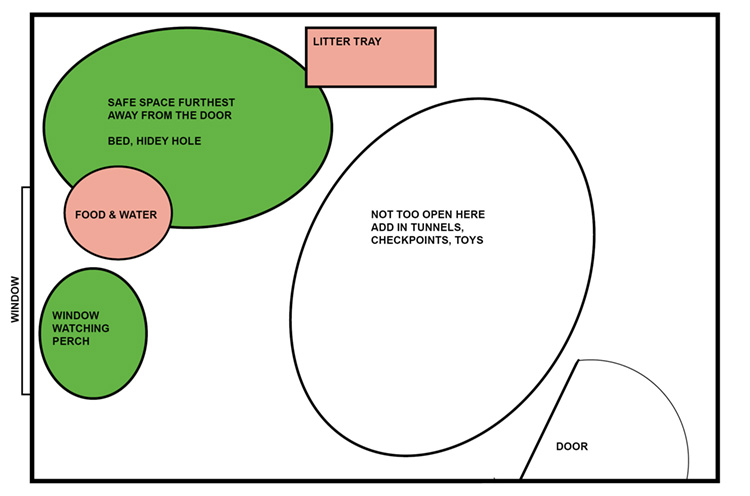Choosing and prepping your room for a nervous or newly-adopted cat
A spare room is best that you will not need to go into except to be with the cat. Remove any hazards and move or block access to gaps underneath or behind furniture. Cushions and blankets can be used to stuff underneath a chest of drawers, make sure the chimney is closed off as they can climb brickwork, and lock your windows.
A utility room is not a good choice, as you are in and out using noisy machines, plus you’ll be surprised how a cat can fit behind that washing machine!
What to put in your room
Now you’ve blocked off unsuitable hidey spots, then add some suitable ones back in! Set up a bed and safe space at the point furthest from the door. Two chairs and a blanket or sheet can make a great covered area.

High spots are also important. A large cat tree or shelves work well. You can give a little cover with a pinned sheet.
What else you will need:
- Food and water bowls. It is best to place these apart from each other but near the bed.
- Litter tray. Have this away from the food and water bowls but not too far from their hidey area so it’s not a scary journey to toilet.
- Hidey spots and enrichment (see below).
- A radio on at low volume. Not only does this have voices the cat can get used to hearing, it also lessens any sudden bangs and stomping us humans make.
- Feliway diffuser. These plug-ins are a synthetic pheromone that reinforces a message of safety and familiarity in the home. Turn this on 24 hours before you bring your cat home and keep it on.
- A wildlife camera. This is recommended so you can keep an eye on them and also it is a lot of fun! You can pick some up from about £20.
- Once you have the key resources in place, do not move them around.

Example of a room set up
Hidey spots, checkpoints and enrichment
Providing these will help your cat explore and feel more comfortable with you around and by themselves. It doesn’t have to be expensive items and often children’s toys can be repurposed. Here are our favourites:
- Play tunnels.
- Wigwam or playhouses
- Carboard boxes with holes cut into the side for viewing and play
- A viewing spot out the window. A shelf, radiator bed or similar near a window will be very popular.
- Wand toys – these are variations of feathers or ribbons on a stick. This keeps you at a good distance and can create tempting movement in the air or along the ground. For more toy ideas, please see our ‘Cat play’ page for more details.
Ongoing care
Your cat will need to have food and water provided every day, but also spend time in the same room as your cat a few times a day. See our ‘Making friends with nervous cats’ page.
Always go into their room at the same times each day and, before you enter, knock on the door so the cat has a chance to hide. The routine will be very reassuring to the cats so they can relax in between visits.
Once your cat seems comfortable with your presence in the room (e.g. not hiding away, out in the open and happy to be handled), you can start to expand their base one room at a time. The hallway is usually the next room. Close all the doors to the other rooms and again have a hazard/furniture/small space access check and plug any gaps with blankets or cushions.
Keeping access to their secure room open in case they need to retreat, move one of their play tunnels near the doorway which they will use as a checkpoint – that is, somewhere to run to and safely stop and check out the new space. Stay with them in the hall, initially ignoring them and letting them relax and look around without coaxing or interrupting.
Once you feel they are settled, try and instigate a play or offer tasty treats as you would in their secure room. Some cats will quickly adapt to opening up the house, others will need more time. Learning where your cat is comfortable will be part of your bonding. Do this step by step right until they are comfortable going out into the garden, always let them outside before a meal, so you can reward them with dinner or a snack and they’ll learn to come when called.
Always check for hazards and open windows before letting your cat have access to a new room, and always let them choose to go back to their secure room if they want to.
When a cat chooses to enter a new room you are in, don’t make a fuss about it, just say hello and let them explore and come to you.